Corporate-startup collaboration has emerged as a powerful strategy for established firms looking to drive innovation, rejuvenate their operations, and enhance productivity. In an era where agility and technological disruption define success, incumbent firms increasingly seek out startups as strategic partners. These collaborations allow companies to access cutting-edge technologies, experiment with new business models, and accelerate the pace of learning, which is crucial for corporate entrepreneurship.
One key benefit of corporate-startup collaboration is the ability to tap into the innovation capabilities of startups, which are often focused on disruptive technologies and rapid problem-solving. Established firms, burdened by complex hierarchies and legacy systems, can benefit greatly from the flexibility and creativity that startups bring. Through these partnerships, incumbents can implement solutions that would otherwise take much longer to develop internally.
A particularly effective model within corporate-startup collaboration is Venture Clienting. This approach allows big firms to become early customers of startups, thus integrating their innovative products or services into their operations without large financial investments or equity stakes. By doing so, established companies can test new technologies and processes at lower risk, while also giving startups the chance to refine their offerings through real-world application.
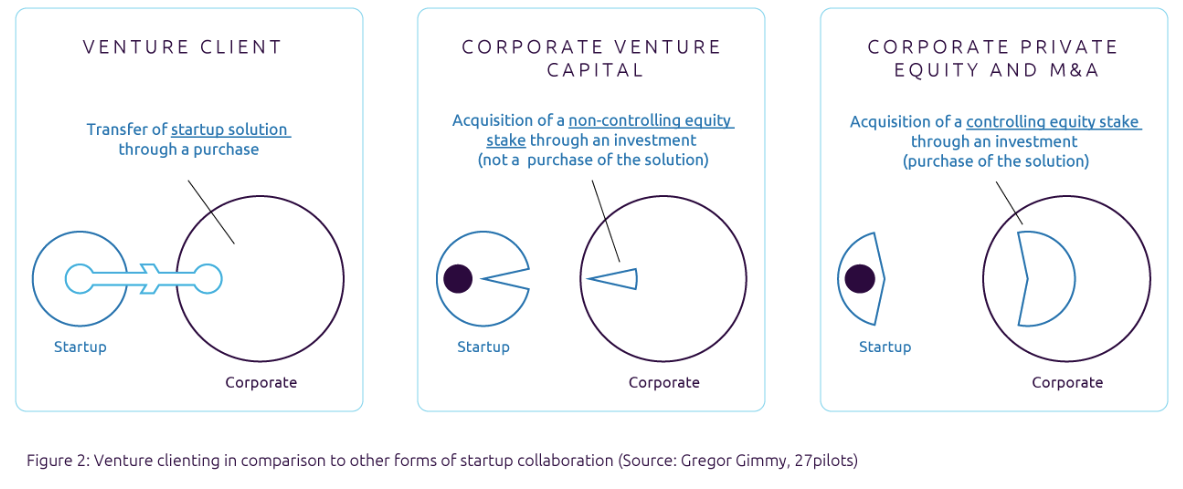
The Venture Clienting Model offers significant advantages in corporate-startup collaboration, such as optimising processes and costs while promoting organisational renewal. However, these partnerships also come with challenges. Differences in company culture, governance structures, and negotiation power can complicate collaboration efforts. For instance, startups, accustomed to working in fast-paced, informal environments, may struggle with the more bureaucratic procedures of large corporations. Similarly, established firms may find it difficult to adapt their slower, hierarchical decision-making processes to match the startup’s agility.
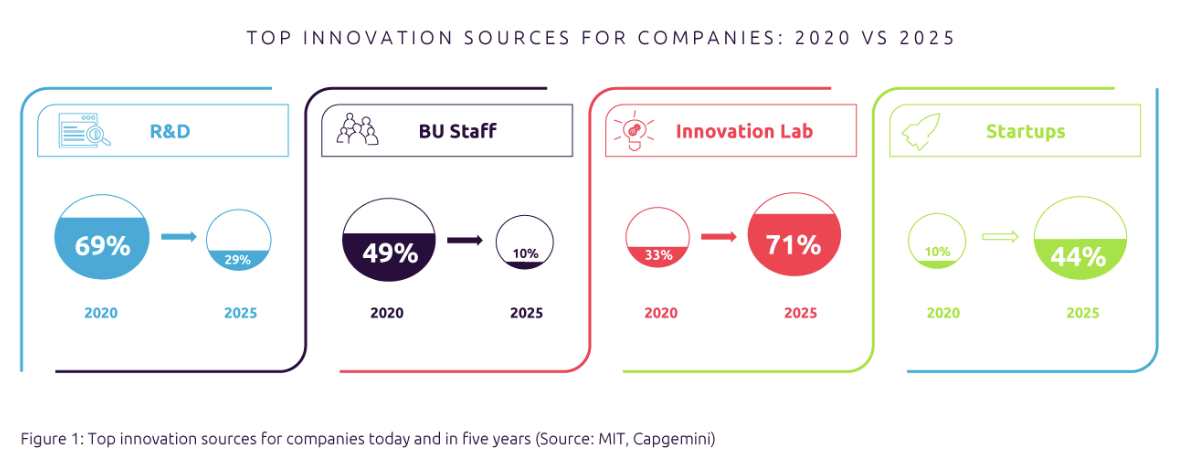
To overcome these barriers, big companies must develop dynamic capabilities that enhance their ability to manage corporate-startup collaboration. These capabilities include sensing opportunities in the market, seizing them through effective integration of startup innovations, and transforming their internal processes to fully leverage the partnership. The development of these capabilities typically follows a progression, moving from early-stage exploration to more advanced stages where integration becomes more complex.
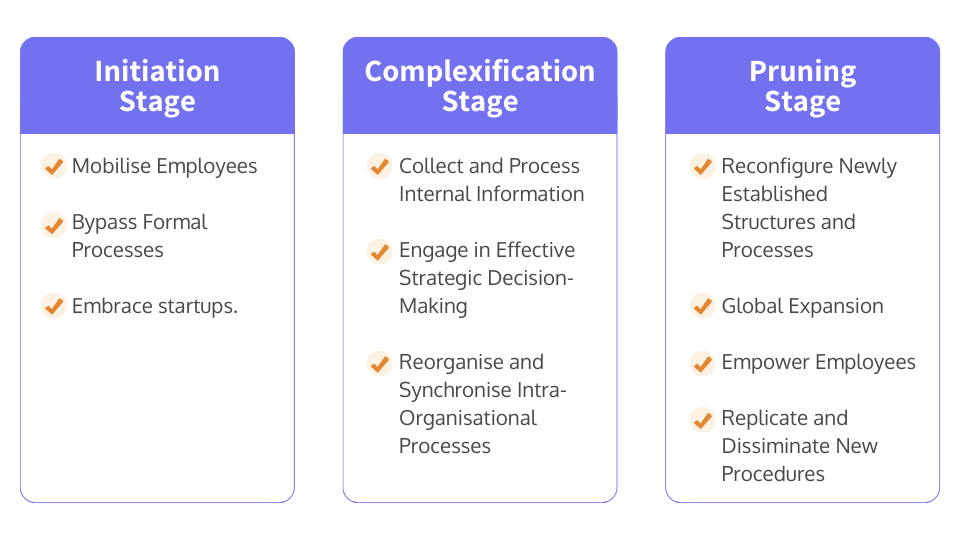
Source: Baumgärtner L. D., Stoffregen R., Soluk J., Kammerlander N., and Gimmy G. (2024). “Harnessing the innovative potential of start-ups for corporate entrepreneurship in incumbent firms: a study of asymmetric buyer–supplier relationships”, R&D Management.
At each stage, corporations must adapt their strategies to ensure the relationship evolves productively. Early stages often involve the identification and assessment of startup technologies that align with the firm’s strategic goals. As the collaboration matures, incumbents shift focus to implementing these innovations and reconfiguring their internal resources to extract maximum value. This iterative process of sensing, seizing, and transforming helps firms stay competitive in a rapidly changing business environment.
In the initiation stage of corporate-startup collaboration, companies often grapple with how to effectively integrate startup innovations into their established structures. While many companies have experience with venture capital investments or startup partnerships, they frequently find that merely closing deals doesn’t automatically translate to increased innovation within their business units. This realisation has prompted decision makers to explore more hands-on approaches (such as Venture Clienting).
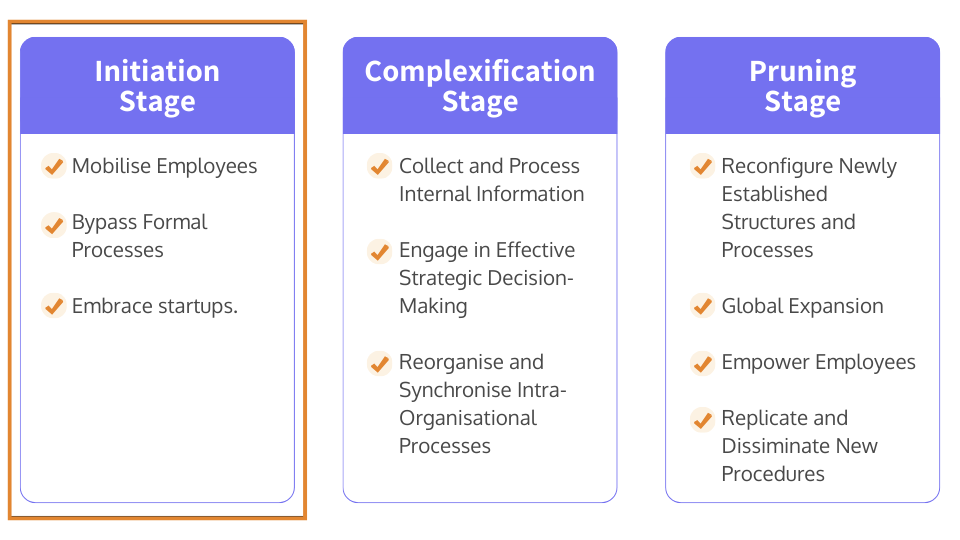
At the beginning of this journey, one of the key challenges is mobilising employees to embrace startup collaborations. Initially, employees are often hesitant to work with startups, perceiving them as risky and unfamiliar. To overcome this resistance, firms develop the capability to mobilise their workforce. This involves introducing roles like “partnership managers” who act as champions of the Venture Clienting process, guiding employees through the initial phases of collaboration. By creating awareness and showcasing the value of startup innovations through internal pitch events, these managers help foster a sense of excitement and engagement among employees.
Established corporations are often burdened by rigid procurement and approval processes, which can stifle the agility needed to collaborate effectively with startups. Partnership managers play a crucial role in negotiating for flexibility, securing short-term pilot projects that allow the firm to test new technologies without getting bogged down in lengthy bureaucratic procedures. While this approach enables faster integration of startup innovations, it’s clear that long-term success will require more streamlined routines to avoid dependency on individual negotiations.
Another critical capability developed during this stage is the ability to embrace startups by fully understanding their value propositions. Partnership managers work to align the innovative technologies of startups with specific business needs within the organisation. By codifying knowledge and creating shareable processes, they ensure that the potential of these technologies is communicated effectively across departments, encouraging wider adoption. This process of alignment is key to making the collaboration sustainable and impactful.
Despite the early successes of these initiatives, many firms face what some insiders call the “pilot-to-death” problem—where startup collaborations launch numerous pilots but fail to scale their innovations beyond the testing phase. To avoid this, companies need to shift their focus from simply initiating partnerships to ensuring that these pilots lead to tangible, long-term innovations that contribute to corporate entrepreneurship.
In the complexification stage of corporate-startup collaboration, organisations begin to develop three key capabilities that help them not only seize innovation opportunities but also ensure that these initiatives have a lasting impact on corporate entrepreneurship.
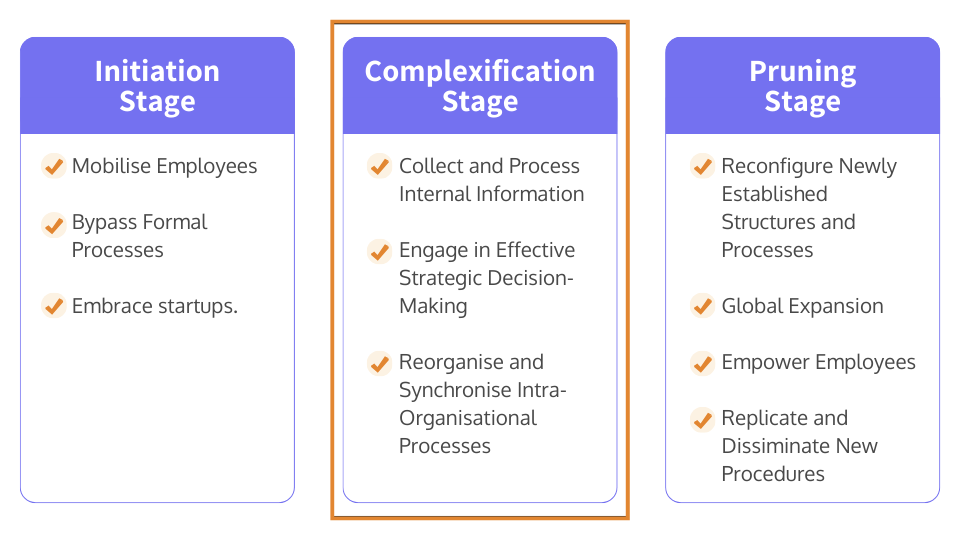
At this stage, companies realise that simply identifying promising startups isn’t enough. They need a structured approach to align the startups’ innovations with actual business needs. To do this, firms often create a network of internal champions—employees from various departments who act as innovation scouts, identifying gaps or opportunities within their units and providing valuable insights to the partnership managers. This collaboration ensures that Venture Clienting isn’t just an abstract concept but directly addresses specific, actionable needs within the business.
A significant enabler of this process is governance. By automating low-value tasks and freeing up partnership managers to focus on high-impact activities, organisations enhance their ability to collect and analyse internal data. This improved transparency and information flow enables better decision-making and streamlines the Venture Clienting process.
As innovation projects grow in complexity, firms establish dedicated innovation boards or senior management routines to prioritise which startup collaborations should move forward. This ensures that resources are allocated efficiently, and projects with the highest potential for business impact are fast-tracked. In contrast to the early stage, where the costs of pilot projects were often fully covered by the partnership unit, the complexification stage shifts some financial responsibility to individual business units. This approach encourages a more focused investment in genuinely valuable projects, ensuring that only the most relevant innovations are pursued.
Large organisations often face challenges when integrating startup technologies due to mismatches between their established systems and the fast-paced nature of startups. To bridge this gap, firms create tailored procurement processes for startups that are more agile and aligned with the organisation’s product and production cycles. For instance, some companies divide procurement into two phases, allowing them to quickly launch pilots with minimal legal or IT-related assessments and address these more complex issues only after a successful pilot. This flexibility allows corporations to move faster, while still maintaining the necessary safeguards to protect intellectual property and ensure data security.
By synchronising Venture Clienting with other critical internal processes, such as product development timelines, companies ensure that they can implement startup innovations at the right time. This alignment is crucial for avoiding delays and maximising the impact of new technologies, especially in industries where product development cycles are long and require precise timing.
This stage is about moving from experimental, one-off pilots to scalable, impactful innovations that drive real business value. The development of these new capabilities—enhanced information collection, strategic decision-making, and process synchronisation—ensures that corporate-startup collaborations evolve into long-term, sustainable partnerships that truly foster corporate entrepreneurship. This stage marks a turning point where companies transition from merely testing innovative solutions to fully integrating them into their core operations, unlocking the full potential of their startup collaborations.
In the pruning stage of corporate-startup collaboration, companies shift their focus from incremental improvements to a deeper integration of disruptive innovations. At this point, firms are no longer just optimising efficiency or improving productivity—they are looking to make a strategic impact by incorporating groundbreaking technologies and reconfiguring internal processes. However, this transition brings new challenges, requiring companies to rethink their structures, processes, and even their approach to innovation.

After making strides during the complexification stage, companies realise that some of their existing systems may now be limiting their potential to scale innovation. For example, some firms streamline their decision-making processes by eliminating layers of bureaucracy, such as innovation boards, to enable faster adoption of start-up technologies. The goal here is to create a more agile, flexible organisation capable of responding quickly to disruptive innovations.
Firms recognise the need to standardise their Venture Clienting processes across regions to ensure that innovation is not limited to specific geographies. This requires a fine-tuned governance structure that can operate efficiently on a global scale while still allowing local innovation hubs to thrive. Knowledge transfer also plays a crucial role, as firms benchmark their processes against others in the industry to ensure they are adopting the best practices.
In earlier stages, partnership managers often took the lead on managing startup collaborations. However, as Venture Clienting becomes more ingrained in the organisation, employees—especially champions within business units—start to assume greater responsibility. These champions take over decision-making and project management roles, effectively decentralising the governance of innovation projects. This shift allows the organisation to scale its Venture Clienting efforts without relying solely on a centralised partnership unit.
This empowerment also enables more strategic innovation. Instead of focusing on immediate problems, champions and partnership managers work together to dive deeper into the root causes of challenges and explore how startups can address more fundamental issues. This more nuanced approach leads to solutions that are not just incremental but truly disruptive, driving transformational change within the organisation.
By formalising knowledge and creating structured routines, firms ensure that their Venture Clienting efforts are not isolated to a few departments but become an organisation-wide practice. For instance, training programs are revamped to focus on how to work effectively with startups, and success stories are shared across departments to build credibility and momentum. This codification of knowledge helps institutionalise the practice of corporate-startup collaboration, making it a sustainable part of the firm’s innovation strategy.
By balancing both product and process innovations, firms in the pruning stage are able to demonstrate real business impact. Some companies focus on disruptive product innovations, such as entering new markets by leveraging startup platforms, while others enhance their operational efficiency by integrating start-up technologies into their manufacturing processes. This balance is essential for ensuring that venture clienting not only contributes to the company’s strategic goals but also delivers tangible financial results.
In essence, this stage marks a period of refinement and growth, where firms reconfigure their internal structures to better harness the full potential of start-up technologies. By empowering employees, streamlining processes, and disseminating best practices, companies are able to move beyond surface-level innovation and achieve lasting, strategic impact through corporate-startup collaboration.
What do you think about this topic? Share your opinion with us on LinkedIn!